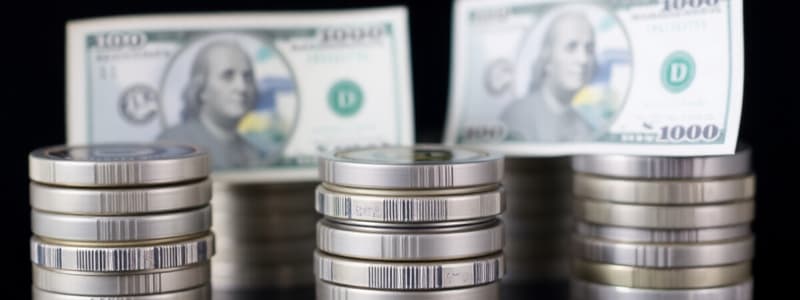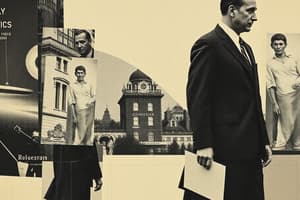Podcast
Questions and Answers
If a country's central bank observes a decrease in the general price level, which economic condition are they most likely observing?
If a country's central bank observes a decrease in the general price level, which economic condition are they most likely observing?
- Inflation
- Disinflation
- Stagflation
- Deflation (correct)
How does inflation typically affect those on fixed nominal incomes, such as pensioners?
How does inflation typically affect those on fixed nominal incomes, such as pensioners?
- Decreases their real income as the purchasing power of their income falls. (correct)
- Increases their savings due to higher interest rates.
- Increases their real income because nominal income is constant.
- Has no impact on their real income since their income is fixed.
In an economy experiencing deflation, how are households likely to adjust their spending behavior, and what impact does this have on aggregate demand?
In an economy experiencing deflation, how are households likely to adjust their spending behavior, and what impact does this have on aggregate demand?
- Maintain current spending levels, resulting in no change to aggregate demand.
- Shift spending from services to durable goods, altering the composition of aggregate demand.
- Decrease spending, which amplifies negative shocks to aggregate demand. (correct)
- Increase spending, leading to higher aggregate demand.
What is the primary concern regarding erratic changes in relative prices due to high inflation for producers in an economy?
What is the primary concern regarding erratic changes in relative prices due to high inflation for producers in an economy?
If the nominal wage increases by 5% and the price level increases by 3%, what is the approximate change in the real wage?
If the nominal wage increases by 5% and the price level increases by 3%, what is the approximate change in the real wage?
How is the bargaining gap defined in the context of labor market equilibrium and inflation?
How is the bargaining gap defined in the context of labor market equilibrium and inflation?
What does a positive bargaining gap indicate about the labor market and its impact on inflation?
What does a positive bargaining gap indicate about the labor market and its impact on inflation?
What is likely to happen in an economy if firms respond to an increase in production costs by maintaining their profit margins?
What is likely to happen in an economy if firms respond to an increase in production costs by maintaining their profit margins?
If an economy implements protectionist policies, barring foreign firms from entering the market, what is the likely consequence regarding inflation?
If an economy implements protectionist policies, barring foreign firms from entering the market, what is the likely consequence regarding inflation?
In a deflationary environment, how would you expect firms to adjust their prices and why?
In a deflationary environment, how would you expect firms to adjust their prices and why?
How does employment level relative to N* (the equilibrium level) correlate with inflation, according to economic models?
How does employment level relative to N* (the equilibrium level) correlate with inflation, according to economic models?
In the context of the Phillips curve, what relationship does it describe between inflation and unemployment?
In the context of the Phillips curve, what relationship does it describe between inflation and unemployment?
What is the significance of A.W. Phillips' contribution to understanding inflation, particularly concerning the Phillips curve?
What is the significance of A.W. Phillips' contribution to understanding inflation, particularly concerning the Phillips curve?
According to Milton Friedman's perspective on the Phillips curve, what explains the upward shift of the curve over time?
According to Milton Friedman's perspective on the Phillips curve, what explains the upward shift of the curve over time?
What are the two main additional features that help explain wage-price spirals, according to the content?
What are the two main additional features that help explain wage-price spirals, according to the content?
In the context of wage-price spirals, what does 'adaptive expectations' mean, and how does it affect inflation?
In the context of wage-price spirals, what does 'adaptive expectations' mean, and how does it affect inflation?
In an economy where wages and prices are both growing at 3% in labor market equilibrium, and a boom lowers unemployment, what initial effect might occur?
In an economy where wages and prices are both growing at 3% in labor market equilibrium, and a boom lowers unemployment, what initial effect might occur?
If workers anticipate a 3% rise in prices and require an additional 2% real wage increase, what total nominal wage increase would they seek?
If workers anticipate a 3% rise in prices and require an additional 2% real wage increase, what total nominal wage increase would they seek?
If, in the second year, workers with adaptive expectations anticipate prices to rise by 5% and still require an additional 2% real wage increase, by how much would nominal wages and prices increase?
If, in the second year, workers with adaptive expectations anticipate prices to rise by 5% and still require an additional 2% real wage increase, by how much would nominal wages and prices increase?
According to the content, what does the acronym NAIRU stand for, and what does it represent?
According to the content, what does the acronym NAIRU stand for, and what does it represent?
How does the vertical Phillips curve (VPC) differ from the usual Phillips curve (PC) in terms of economic assumptions?
How does the vertical Phillips curve (VPC) differ from the usual Phillips curve (PC) in terms of economic assumptions?
What is the primary strategy involved in the 'gradualist' approach to disinflation?
What is the primary strategy involved in the 'gradualist' approach to disinflation?
How does the 'cold turkey' approach differ from the 'gradualist' approach in disinflation strategies?
How does the 'cold turkey' approach differ from the 'gradualist' approach in disinflation strategies?
Monetary policies are made under the preferences of which entity?
Monetary policies are made under the preferences of which entity?
What condition defines the optimal inflation rate relative to unemployment, according to the content?
What condition defines the optimal inflation rate relative to unemployment, according to the content?
What is the main premise behind 'inflation targeting' as a modern monetary policy?
What is the main premise behind 'inflation targeting' as a modern monetary policy?
How does central bank independence contribute to managing inflation expectations in modern monetary policy?
How does central bank independence contribute to managing inflation expectations in modern monetary policy?
Referring to Figure 2, how would you describe the state of the labor market when operating at point C?
Referring to Figure 2, how would you describe the state of the labor market when operating at point C?
Figure 9 visually represents which of the two Phillip curves
Figure 9 visually represents which of the two Phillip curves
What does Figure 11's graphical shape indicate about unemployment rates in an economy where policy makers are following a gradualist approach?
What does Figure 11's graphical shape indicate about unemployment rates in an economy where policy makers are following a gradualist approach?
When considering a central bank monetary policy, what is something that does NOT occur?
When considering a central bank monetary policy, what is something that does NOT occur?
With the knowledge of historical inflation rates of 2010 and a target inflation rate, what factor most likely influences central adoption?
With the knowledge of historical inflation rates of 2010 and a target inflation rate, what factor most likely influences central adoption?
When undergoing wage and price spirals, which action describes the results and consequences that most accurately impacts the government's role?
When undergoing wage and price spirals, which action describes the results and consequences that most accurately impacts the government's role?
What defines workers to increase their expectations when undergoing a deflation?
What defines workers to increase their expectations when undergoing a deflation?
Under what circumstance would disinflation occur?
Under what circumstance would disinflation occur?
How does high inflation affect the ability of producers to make informed decisions about resource allocation?
How does high inflation affect the ability of producers to make informed decisions about resource allocation?
What is the likely result of households postponing consumption due to expected future price decreases?
What is the likely result of households postponing consumption due to expected future price decreases?
How do firms typically respond to a positive bargaining gap? (Assume constant profit margins).
How do firms typically respond to a positive bargaining gap? (Assume constant profit margins).
Which action best describes the effects that the government can take when markets are less competitive?
Which action best describes the effects that the government can take when markets are less competitive?
If a boom lowers unemployment to 3% in an economy where both wages and prices grow at 3% in labor market equilibrium, creating a bargaining gap of 2%, what is the most likely initial effect?
If a boom lowers unemployment to 3% in an economy where both wages and prices grow at 3% in labor market equilibrium, creating a bargaining gap of 2%, what is the most likely initial effect?
How would you describe the state of the labor market at point C in Figure 2?
How would you describe the state of the labor market at point C in Figure 2?
What is the primary implication of the vertical Phillips curve (VPC) for economic policy?
What is the primary implication of the vertical Phillips curve (VPC) for economic policy?
What is a key difference between the 'gradualist' and 'cold turkey' approaches to disinflation?
What is a key difference between the 'gradualist' and 'cold turkey' approaches to disinflation?
In modern monetary policy, what role does central bank independence play in managing inflation?
In modern monetary policy, what role does central bank independence play in managing inflation?
Refer to Figure 8, what conclusion can be made about inflation expectations?
Refer to Figure 8, what conclusion can be made about inflation expectations?
Figure 9 shows what change a boom has on a Phillips Curve, assuming the natural rate is stable. What event also occurs?
Figure 9 shows what change a boom has on a Phillips Curve, assuming the natural rate is stable. What event also occurs?
What is the most accurate meaning of NAIRU?
What is the most accurate meaning of NAIRU?
When undergoing wage and price spirals, higher wages will have what affect?
When undergoing wage and price spirals, higher wages will have what affect?
Optimal indifference curves determine feasible indifference. What are they affected by?
Optimal indifference curves determine feasible indifference. What are they affected by?
Flashcards
Inflation
Inflation
An increase in the general price level of goods and services in an economy.
Zero Inflation
Zero Inflation
A constant price level from year to year; no change in the price level.
Deflation
Deflation
A decrease in the general price level, meaning prices are falling.
Disinflation
Disinflation
Signup and view all the flashcards
Rising Inflation
Rising Inflation
Signup and view all the flashcards
Menu Costs
Menu Costs
Signup and view all the flashcards
Real Wage
Real Wage
Signup and view all the flashcards
Bargaining Gap
Bargaining Gap
Signup and view all the flashcards
Positive Inflation
Positive Inflation
Signup and view all the flashcards
Deflation
Deflation
Signup and view all the flashcards
Phillips Curve
Phillips Curve
Signup and view all the flashcards
NAIRU
NAIRU
Signup and view all the flashcards
Wage-Price Spiral
Wage-Price Spiral
Signup and view all the flashcards
Vertical Phillips' Curve
Vertical Phillips' Curve
Signup and view all the flashcards
Gradualist Disinflation
Gradualist Disinflation
Signup and view all the flashcards
Cold Turkey Disinflation
Cold Turkey Disinflation
Signup and view all the flashcards
Monetary Rule
Monetary Rule
Signup and view all the flashcards
Inflation Targeting
Inflation Targeting
Signup and view all the flashcards
Postpone Consumption
Postpone Consumption
Signup and view all the flashcards
Study Notes
Key Terms on Inflation
- Inflation is an increase in the general price level.
- Zero inflation is a constant price level from year to year.
- Deflation is a decrease in the general price level.
- Disinflation is a decrease in the rate of inflation.
- Zero inflation means that the car is stationary.
- Constant inflation means that the car is moving at a constant speed.
- Disinflation means that the car is decelerating, such as when you brake.
- Deflation means that the car is moving backward.
- Rising inflation is an increase in the rate of inflation.
- Rising inflation is like a car accelerating when gas is applied.
Issues With Inflation
- Higher inflation reduces the real value of income for people on fixed nominal income like pensioners.
- Inflation reduces the real value of debt, which is beneficial for borrowers but unfavorable for creditors.
- High inflation rates can make the economy function less efficiently.
- Firms face "menu costs" requiring frequent price updates.
- Erratic prices obscure scarcity and profitability signals, hindering producers from distinguishing between relative price changes and inflation.
- Uncertainty increases, discouraging investment.
Issues With Deflation
- Falling prices will cause households to postpone consumption, particularly of durables, due to expectations of lower prices in the future, having a similar effect to a negative shock to aggregate demand.
- Deflation increases the real debt burden, which may lead borrowing households to cut consumption further reducing aggregate demand.
- High inflation and deflation are undesirable.
- Economists in the U.K. agree that the ideal rate of inflation is 2% per year.
- The Bank of England aims to maintain a 2% rate of inflation.
Real Versus Nominal Wage
- Real wage is the nominal wage (W) divided by the price level (P).
- Workers prioritize real wage.
- Both the price setting and wage setting curves feature real wage on the vertical axis.
Labour Market Equilibrium
- Labour Market Equilibrium is where the price-setting curve intersects the wage-setting curve.
- At Labour Market Equilibrium employment is equal to N*.
- At Labour Market Equilibrium Workers' claims to real wages + firms' claims to real profits = total productivity.
- The claims on output by workers and firms need to be consistent.
The Bargaining Gap
- The bargaining gap is the difference between the real wage required to incentivize effort (wage setting curve) and the real wage that gives firms enough profits to stay in business (price setting curve).
- At labour market equilibrium, the bargaining gap is zero because the wage setting curve intersects the price setting curve.
- When claims on output are consistent (bargaining gap is zero), inflation is also zero.
Positive Inflation
- Positive inflation results when employment is above N*.
- With Positive Inflation Workers' claims to real wages + firms' claims to real profits > total productivity .
- A positive bargaining gap comes from the wage setting curve lying above the price setting curve.
- Lower unemployment makes it easier for employees to leave their job.
- Motivating workers requires paying higher nominal wages (shown by the wage setting curve).
- The cost of production is higher
- Firms pass increased production costs onto consumers through higher prices due to firm unwillingness to reduce their profit margin
- Positive Inflation occurs when firms raise prices.
- Resultant inflation equals the bargaining gap in percentage terms.
- Real wages do not change when prices and wages both rise by the same percentage (equal to the bargaining gap), and the process restarts.
Factors That Can Cause a Positive Bargaining Gap
- An increase in bargaining power for firms over consumers (reduction in competition).
- The price setting curve shifts downwards, indicating higher profit margins.
- An increase in bargaining power for workers over firms.
- The wage setting curve shifts up.
- In each case, positive inflation results.
- Suppose the government adopts protectionist policies.
- Markets become less competitive, so firms can charge a higher mark-up over costs.
- Firms raise prices.
- Workers lack the motivation to work, since real wages will fall.
- To build up motivation, workers need higher nominal wages
- Production costs increase and firm will pass the higher costs on to consumers with higher prices.
- The result is positive inflation.
Deflation
- Deflation takes place when employment is below N*.
- With Deflation Workers' claims to real wages + firms' claims to real profits < total productivity .
- This results in a negative bargaining gap.
- The output per worker is more than enough to satisfy the claims of workers and firms.
- The deflation that results is equal to the negative bargaining gap.
The Phillips Curve
- When employment is N*, inflation is zero.
- When employment is is above N*, inflation is positive.
- When employment is below N*, inflation is negative.
- There is a relationship between inflation and employment.
- There is a negative relationship between inflation and unemployment.
- This relationship is referred to as the Phillips curve.
- The Phillips curve can be derived from the price-setting and wage setting curves.
- The Keynesian cross diagram can be added to the Phillips curve.
- Labor productivity is assumed to be 1, which implies that output and employment are the same.
- High aggregate demand leads to low unemployment and inflation.
- Low aggregate demand leads to high unemployment and deflation.
- A.W. Phillips published a comparison of annual wage inflation and unemployment in the British economy from 1861 to 1913.
- Studies show a negative relationship between inflation and unemployment.
- Policymakers can select low unemployment and high inflation or high unemployment and low inflation.
- A Phillips Curve does not exist from 1960 to 2010 in the U.S.
- The Phillips curve shifted upwards over time.
- Milton Friedman explained this at an American Economic Association address in December 1967.
Wage Price Spirals
- Milton Friedman argued against the Phillips Curve, stating that it was not stable and shifts upwards over time.
- High unemployment rates will coincide with greater inflation.
- Since 1966 unemployment had been steady at 3.7% but inflation had increased from 3% to 4.2%.
- This is accelerating or rising inflation.
- Inflation rises because the government tried to keep unemployment “too low", or employment “too high".
- Keeping employment above N* would cause high inflation and rising inflation.
- Rising or accelerating inflation is called a wage-price spiral.
- Wage-price spirals can be explained incorporating two additional features:
- Non-zero inflation in labour market equilibrium
- Adaptive expectations
- Even at equilibrium inflation is not zero but positive.
- Wages are indexed for inflation in advanced economies, so wages rise at the same rate as prices.
- There is a constant (but positive) inflation in equilibrium.
- People expect future inflation to be the same as the previous year.
- Both wages and prices grow at 3% in a labour market equilibrium.
- Equilibrium unemployment is 6%.
- A boom takes the economy with 3% unemployment
- A bargaining gap exists where the distance between wage setting and the price setting curve is 2%.
- Workers expect prices to rise by 3% and require a 3% nominal wage increase to keep their real wages unchanged.
- Since they require an additional real wage increase of 2%, nominal wages would rise by 3%+2%=5%.
- Employers will increase prices by 5% to maintain profit margins.
- The inflation rate increases from 5% to 7%.
- In year 2 workers expect prices to rise by 5%
- Workers need a 5% nominal wage increase to keep their real wages unchanged
- Since workers require an additional 2% actual wage increase, nominal wages increase by 7%.
- To keep margins intact, employers increase prices, which increases inflation from 5% to 7%
- Inflation keeps rising every year.
- inflation rate (%) = expected inflation (%) + bargaining gap (%)
- Inflation rate (inflation last year (%) + bargaining gap (%).
- Evolution of inflation can be shown at labour market equilibrium (unemployment is 6%) and in a boom (unemployment is 3%).
- N*, the unemployment rate in labour market equilibrium is called the non-accelerating inflationary rate of unemployment rate (NAIRU).
- N* is the natural rate of unemployment.
- Rising inflation results if employment rate rises above N*.
- Falling employment rate below N* causes deflation and disinflation.
- An alternative method to illustrate the Phillips curve is plotting output rather than employment on the horizontal axis.
- The curves would look identical if labor productivity = 1.
- VPC, represents the fact that there is no long term trade off between inflation and unemployment.
- The long run Phillips' curve (LRPC) is the vertical Phillips' curve.
- Phillips curve (PC) curve(SRPC, Phillips curve short run) expresses the short run trade off between inflation and unemployment.
Disinflation Strategies
- A country can counter a wage-price spiral with two strategies.
- "Gradualist”
- “Cold turkey" approaches.
- Policy should increase the unemployment rate.
- First, pursue contractionary monetary policy.
- Unemployment increases to NAIRU.
- This stabilizes high inflation.
- The central bank wants to bring it down to 2% using the gradualist approach.
- The central bank raises unemployment and reduces output.
- In the next period the Phillips' curve shifts downwards.
- The economy is guided to a spot over periods of time.
- A monetary rule is the path joining central bank preferences.
- Monetary policy is a more inflation averse central bank, known as "cold turkey".
- The central bank wishes to bring inflation down in just one period choosing a new output level.
- In the next period, the central bank can cut interest rates to stabilize output
- The economy shifts, which monetary policy dictates.
Monetary Rules
- Monetary rules emerge from central bank preferences.
- Central bank preferences can be expressed by indifference curves.
- Indifference curves show policymaker's preferred tradeoffs between inflation and unemployment (MRS).
- The Phillips' curve determines the feasible set.
- The Phillips Curve determines the feasible trade-offs between inflation and unemployment (MRT).
- An optimal inflation rate happens which MRS = MRT.
- Optimal inflation rate is the points of tangency between indifference curve and Phillips' curve.
- The line joining these points of tangency is the monetary rule.
Modern Monetary Policy
- Modern monetary policy is called “inflation targeting monetary policy”.
- Inflation is taken much more seriously than recession.
- Inflation targeting involves the central bank using policy instruments to keep the economy close to an inflation target.
- Central bank independence is another quality of modern monetary policy.
- To prevent an inflation spiral, central bank independence give inflation credibility.
Studying That Suits You
Use AI to generate personalized quizzes and flashcards to suit your learning preferences.




